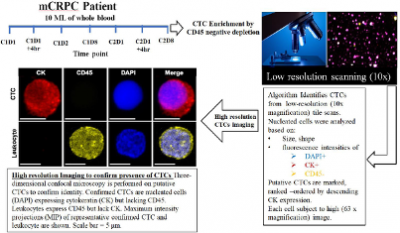Content #1
Content #1
Content #1
Microtubule-targeting drugs such as taxanes (docetaxel and cabazitaxel) represent one of the most clinically active chemotherapy drugs for the treatment of solid tumors, particularly for metastatic castration-resistant prostate cancer (mCRPC). Taxanes bind to the beta-tubulin subunit of microtubules (MT) which leads to MT stabilization and increase in MT polymer mass. The efficacy of taxane binding to tubulin may be visualized by the reorganization of the MT network into distinct MT bundles, which is indicative of effective drug-target engagement (DTE). Yet, clinical studies that have assessed MT-DTE as a potential biomarker for taxane chemotherapy response are lacking.
In a recent publication in Cancer Drug Resistance, Mukhtar et. al investigated the role of MT-DTE as a potential biomarker for taxane chemotherapy efficacy in mCRPC patients. The authors isolated circulating tumor cells (CTCs) of three mCRPC patients from blood samples taken at various timepoints during treatment with CRXL301, a nanoparticle conjugate of docetaxel. CTCs were enriched by depletion of CD45+ cells followed by immunofluorescence staining. Cells were subsequently immunostained for CD45, tubulin, and pan-cytokeratin (PanCK). The PanCK antibody was directly conjugated to CF®594 using the Mix-n-Stain™ CF® Dye Antibody Labeling Kit. CTCs were then identified by a DAPI+/CK+/CD45– phenotype.
MT-DTE was calculated in confirmed CTCs through a semi-automated scoring algorithm that quantified the integrated density of MT fluorescence. Results show that two CRXL301 non-responding patients had a stable or lower MT-DTE score one week after treatment administration. Meanwhile, a patient who responded to the chemotherapy with a 50% shrinkage in tumor size displayed a consistently higher MT-DTE score at various timepoints one week after treatment. Taken together, these data suggest that increases in MT-DTE after therapy with CRXL301 may be useful for determining treatment response. However, larger prospective clinical studies in solid tumors treated with taxane-based chemotherapy are required to validate these observations.

Learn more about our Mix-n-Stain™ Antibody Labeling Kits as well as CF® Dyes, Biotium’s next-generation fluorophores with superior brightness and photostability.
Full Citation
Mukhtar, E., Worroll, D., Galletti, G., Schuster, S., Piha-Paul, S. A., &Giannakakou, P. (2020). Quantitative analysis of taxane drug target engagement of microtubules in circulating tumor cells from metastatic castration resistant prostate cancer patients treated with CRXL301, a nanoparticle of docetaxel. Cancer Drug Resistance.https://cdrjournal.com/article/view/3425